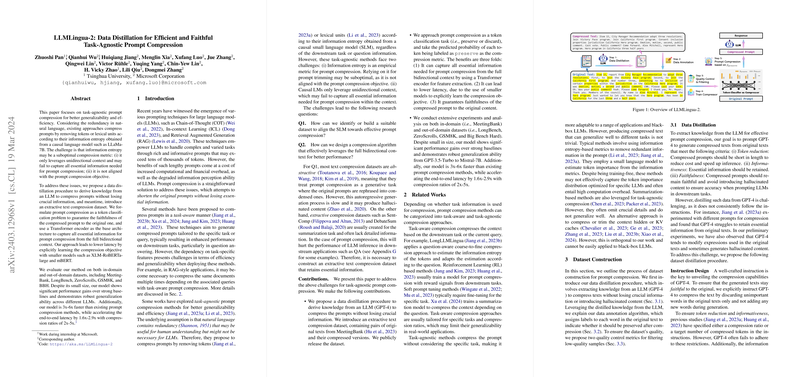LLMLingua-2: Data Distillation for Efficient and Faithful Task-Agnostic Prompt Compression
Abstract
This document presents an overview and an in-depth analysis of the research presented in "LLMLingua-2: Data Distillation for Efficient and Faithful Task-Agnostic Prompt Compression." The paper addresses the challenges of prompt compression in the context of LLMs, presenting LLMLingua-2, a novel approach designed to streamline and enhance the efficiency of prompt compression while ensuring the retention of critical information.
Introduction
Recent advancements in prompting techniques for LLMs, such as Chain-of-Thought (COT), In-context Learning (ICL), and Retrieval Augmented Generation (RAG), have significantly extended the capabilities of these models. However, lengthy prompts, though rich in information, pose substantial computational and financial burdens. Prompt compression aims to mitigate these issues by reducing prompt length without compromising essential information.
LLMLingua-2 departs from existing methods relying on information entropy by introducing a data distillation procedure that leverages knowledge from an LLM to achieve more efficient and faithful prompt compression. This method is task-agnostic, enhancing generalizability and efficiency across various applications.
Methodology
Data Distillation Procedure
LLMLingua-2's data distillation procedure involves using GPT-4 to generate a text compression dataset composed of original and compressed text pairs. This dataset is constructed by prompting GPT-4 to compress texts according to specific instructions focused on retaining crucial information while eliminating redundancy. The prompt compression task is reframed as a token classification problem, allowing a Transformer encoder to leverage bidirectional context for optimal compression.
Extractive Text Compression Dataset
The dataset comprises original texts from MeetingBank and their compressed counterparts, annotated to indicate whether each token should be preserved or discarded. Quality control metrics, such as Variation Rate (VR) and Alignment Gap (AG), ensure the fidelity and effectiveness of the annotation process.
Model Architecture and Training
The token classification model employs a Transformer encoder as the feature extractor, followed by a linear classification layer to predict token retention probabilities. The model is trained on the MeetingBank compression dataset using cross-entropy loss. Crucially, this approach guarantees the faithfulness of the compressed prompts by maintaining the original token sequence and leveraging bidirectional context.
Results
In-Domain Evaluation
The model's performance was evaluated on both QA and summarization tasks within the MeetingBank dataset. LLMLingua-2 demonstrated significant improvements over existing baselines, including Selective-Context and the original LLMLingua. Notably, despite being smaller than LLaMA-2-7B, LLMLingua-2 outperformed these models in terms of QA F1 scores and summary metrics such as BLEU, ROUGE, and BERTScore.
Out-of-Domain Evaluation
The robustness of LLMLingua-2 was further tested on long-context datasets such as LongBench and ZeroSCROLLS, as well as reasoning benchmarks like GSM8K and BBH. The results underscored LLMLingua-2's superior generalizability, achieving higher performance compared to task-agnostic baselines. Even the smaller LLMLingua-2 model (based on multilingual-BERT) surpassed the performance of LLaMA-2-7B-based models.
Efficiency and Latency
LLMLingua-2's model size and efficiency contribute to significant reductions in latency and GPU memory usage. The model accelerates end-to-end latency by 1.6x to 2.9x, offering a compelling advantage in practical deployments. Additionally, the model's peak GPU memory usage is considerably lower than that of comparative models, further enhancing its applicability in resource-constrained environments.
Implications and Future Directions
LLMLingua-2's approach to prompt compression represents a significant stride in improving the efficiency and reliability of LLM applications. The task-agnostic nature of the model ensures broad applicability, while the data distillation procedure guarantees high-quality compression without sacrificing essential information. Future research could explore extending the dataset to cover a wider range of domains, enhancing the model's generalizability further.
Overall, LLMLingua-2 sets a new standard for prompt compression in LLMs, balancing efficiency and fidelity to meet the demands of diverse real-world applications. The model's integration with existing compression frameworks and potential for expansion points to a promising trajectory for ongoing advancements in AI-driven language processing.
